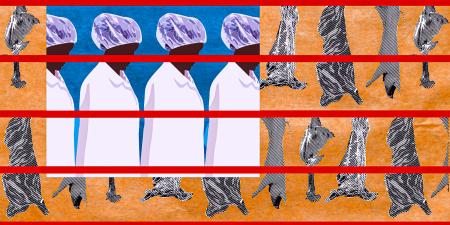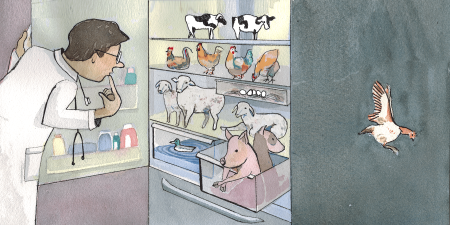Abstract
“Do cattle and other animals know they are walking up a chute that will lead to their death?” Many people ask this question, which the author first had to answer when starting work in the cattle industry. From observations at slaughter plants, feedlots, and ranches, the author learned that cattle behavior was the same when entering a chute for vaccination and when entering a chute for slaughter. If cattle knew they would die, their behavior should have been wilder and more agitated at the slaughter plant, but that was clearly not the case. This article canvasses points of ethical and clinical relevance for discussions about human dietary consumption and practice.
Animals React to Slaughter
Do animals know they are going to be slaughtered? Scientific research has clearly shown that physiological measures of stress during handling are similar at a ranch and at a slaughter plant. Cortisol (stress hormone) levels were in the same range in both places.1,2,3 If the cattle, for example, knew they were going to die, the stress hormone levels should have been much higher at the slaughter plant.
The things that frighten cattle are definitely not the same things that frighten people. Cattle and pigs will often stop and refuse to move through a chute if they see little visual distractions that people do not notice. The distractions might be a coat hung on a fence, sharp shadows from fences that create stripes on the floor, or a dangling chain.4,5 When the visual distractions are removed, the animals will often move more easily through the chute. Animals are also more likely to refuse to move into a chute that has a dark entrance. The addition of a lamp to illuminate a dark entrance will often make cattle and pigs more willing to enter.6,7
At a recent start-up at a new plant, the cattle moved easily through the chute during the daytime, but they often stopped and refused to move forward in the evening. I told the people at this plant to watch the cattle very carefully and observe when they stopped in the system. Cattle and other animals will often stop and look at visual distractions. When we conferenced each other by video call, I observed that a small bright light on the corner of the building caused the problem. Turning the light off improved cattle movement. The cattle were more afraid of a visual distraction than of getting slaughtered. We owe the animals that we use for food a low-stress, good death.
Methods for Rendering Livestock Unconscious
To comply with the Humane Methods of Slaughter Act,8 cattle and other animals must be rendered insensible to pain before they are further processed. To maintain a high standard for obtaining instantaneous insensibility requires management commitment to doing things right. For cattle, the most common method is penetrating captive bolt stunning. When it is done correctly, it is equivalent to shooting an animal with a high-powered firearm. Unconsciousness and insensibility are instantaneous when it is done right.9,10,11 The device is called a captive bolt because the bolt is not a free projectile that would cause a safety hazard. However, supervision and training of employees and daily maintenance of the captive bolt tool are essential. Poor maintenance is a major cause of problems, as animals might wake up and return to sensibility. After stunning, an animal might still continue to kick. This behavior can occur in an animal that is completely brain dead. Kicking can still occur after the spinal cord is cut because the circuits that control kicking are in the middle of the animal’s back.12,13
There are 2 other approved methods of rendering animals insensible prior to slaughter: electric stunning and carbon dioxide gas for pigs and poultry. When electric stunning is used on pigs or sheep, an electric current is passed through the brain. When it is done correctly, the animal is instantly rendered insensible by the induction of grand mal seizures.14,15 Management must be really attentive to ensure that the stunning device is placed in the correct location on the animal’s head so that the electric current passes through the brain.16 Both electric stunning and captive bolt induce instantaneous unconsciousness.
When carbon dioxide gas stunning is used, the induction of insensibility is not instantaneous. To ensure good animal welfare, the behavior of the animal before it loses consciousness and falls down (loss of posture) must be observed. For poultry, carbon dioxide stunning has huge welfare advantages. Many companies are converting to this system because it improves bird welfare. The birds enter the chamber in the same containers they are transported in. This eliminates stressful handling at the slaughter plant. In older electrical stunning systems, the birds are hung live on the conveyor line to present them to an electric water bath. Hanging live birds on the line is very stressful for the birds.17 In modern carbon dioxide stunning systems for poultry, a staged process is used. The travel containers holding the birds progress through a tunnel with gradually increasing levels of carbon dioxide. The birds seldom flap. Wing flapping in conscious birds is a sign of distress. The anesthetic induction process is relatively low stress.18 The process must be continuously monitored to ensure good animal welfare. If the birds flap before loss of consciousness, the carbon dioxide levels will need adjustment.
We owe the animals that we use for food a low-stress, good death.
For pigs, carbon dioxide stunning has become controversial. The handling of the pigs is calm and excellent because they are moved in groups. The use of electric prods to move pigs into a carbon dioxide stunner can be totally eliminated because they are handled in groups. There is a species difference between pigs and chickens, however, in how they react to carbon dioxide. Whereas almost all the chickens remain calm, some pigs have a violent reaction and may attempt to escape from the containers that lower them into high concentrations of carbon dioxide. Other pigs remain calm.19 These differences between pigs may be due to differences in genetics.19,20 The problem might be correctable with selective breeding. The entire system of rendering animals insensible before slaughter must be evaluated, however. When either electric stunning or captive bolt is used in a large plant, the pigs have to move through a single-file chute. This will require the use of an electric prod on about 15% of the pigs. The trade-off between discomfort during anesthetic induction must be balanced against the benefits of eliminating electric prods for moving groups of pigs.
Religious Slaughter
In religious slaughter, cattle, lambs, and poultry are slaughtered by a throat cut with no preslaughter stunning to first render them unconscious. In the United States, federal law permits this process to ensure religious freedom for Jewish kosher slaughter and Muslim Halal slaughter.8 I have discussed this issue in detail with my colleague, Joe Regenstein.21 There are some religious scholars who will accept preslaughter stunning.22
Three animal welfare issues arise when slaughter is done without prelaughter stunning: (1) restraint of the animal, (2) painfulness of the throat cut, and (3) time to lose consciousness. The author has observed that some of the worst animal welfare issues are caused by highly stressful methods of restraint, such as suspending cattle or sheep by one back leg, which are legal. I and my colleague Regenstein have discussed the design of less stressful restraining methods.21 Less stressful methods include restraint boxes to hold the animal. Many kosher and halal slaughter plants have voluntarily stopped suspending animals by one hind leg. To conduct slaughter without first stunning with an acceptable level of animal welfare requires much more attention to details of correct procedures than conventional slaughter with stunning.
An Animal’s Whole Life and Death
It is my opinion that some of the most severe welfare issues are chronic painful conditions that may occur on poorly managed farms. For example, there are a large number of lame dairy cows on some farms, although there are big differences between the percentage of lame dairy cows on the best and the worst dairies.23 Lameness is a condition that causes pain24 and reduces the quality of life for a dairy cow. Both good facilities and management attention can greatly reduce lameness. Some of the methods to reduce lameness are soft, clean bedding in each cow’s stall and quiet, gentle handling.
Often people are more concerned about death than about the animal’s entire life on the farm. A big concern of mine is excessive genetic selection for production traits that may compromise an animal’s welfare on the farm. Overselection for meat, milk, or eggs can sometimes cause problems, such as a sow producing more piglets than she can feed or heart failure in cattle.25,26 I call these problems biological system overload.
Other welfare concerns on the farm are intensive confinement of sows and laying hens.27,28 It is beyond the scope of this paper to discuss all the issues. Welfare specialists agree that, on the farm, suffering must be prevented but animals should also be given some opportunities to have a life worth living.29 There is increasing emphasis on providing animals with opportunities to have positive experiences. If you look up videos of dairy cows using motorized grooming brushes, for example, it is obvious that they really like them.30
Farm animals are not the only animals for which overselection for certain traits has caused welfare problems. The bulldog is a prime example of excessive selective breeding for appearance that severely compromised its welfare. Selection for a massive head and a shortened snout has resulted in problems with breathing and mobility, and almost all the puppies have to be delivered by cesarean section. In fact, the bulldog has greater welfare problems caused by overselection for extreme appearance traits than most farm animals.
Another issue is the effect of raising livestock on the environment. Grazing cattle, sheep, or goats on pasture can improve soil health and regenerate the land.31 There are vast amounts of land where grazing is the only way to raise food on the land, because it is too arid for raising crops.31 Grazing done correctly is truly sustainable, and the animals often have improved welfare. An upshot is that when clinicians make dietary recommendations to patients, they need to realize that a sensible view about animal welfare is a middle ground among many extremist views.
References
- Grandin T. Assessment of stress during handling and transport. J Anim Sci. 1997;75(1):249-257.
- Gruber SL, Tatum JD, Engle TE, Chapman PL, Belk KE, Smith GC. Relationships of behavioral and physiological symptoms of preslaughter stress to beef longissimus muscle tenderness. J Anim Sci. 2010;88(3):1148-1159.
- Mitchell G, Hattingh J, Ganhao M. Stress in cattle assessed after handling, after transport and after slaughter. Vet Rec. 1988;123(8):201-205.
-
Grandin T. The visual auditory and physical environment of livestock handling facilities and its effect on ease of movement of cattle, pigs, and sheep. Front Anim Sci. 2021;2:744207.
-
Willson DW, Baier FS, Grandin T. An observational field study on the effects of changes in shadow contrasts and noise on cattle movement in a small abattoir. Meat Sci. 2021;179:108539.
- Grandin T. Pig behavior studies applied to abattoir design. Appl Anim Ethol. 1982;9(2):141-151.
- Grandin T. Cattle vocalizations are associated with handling and equipment problems at beef slaughter plants. Appl Anim Behav Sci. 2001;71(3):191-201.
-
Humane Slaughter Act, Pub L No. 85-766, 72 Stat 864 (1958).
-
Panel on Humane Slaughter. AVMA guidelines for humane slaughter of animals: 2016 edition. American Veterinary Medical Association; 2016. Accessed December 14, 2022. https://www.avma.org/sites/default/files/resources/Humane-Slaughter-Guidelines.pdf
-
Kline HC, Wagner DR, Edwards-Callaway LN, Alexander LR, Grandin T. Effect of captive bolt gun length on brain trauma and post-stunning hind limb activity in finished cattle Bos taurus. Meat Sci. 2019;155:69-73.
-
Oliveira SEO, Gregory NG, Dalla Costa FA, Gibson TJ, Dalla Costa OA, Paranhos da Costa MJR. Effectiveness of pneumatically powered penetrating and non-penetrating captive bolts in stunning cattle. Meat Sci. 2018;140:9-13.
- Guillner T. Hyman locomotion circuits confirm. Science. 2011;304(6058):912-913.
-
Terlouw EM, Bourguet C, Deiss V, Mallet C. Origins of movements following stunning and during bleeding in cattle. Meat Sci. 2015;110:135-144.
- Lambooy E, Spanjaard W. Electrical stunning of veal calves. Meat Sci. 1982;6(1):15-25.
-
Warrington PD. Electrical stunning: a review of literature. Vet Bull. 1974;44:617-633.
- Gregory NG, Wotton SB. Sheep slaughtering procedures. II. Time to loss of brain responsiveness after exsanguination or cardiac arrest. Br Vet J. 1984;140(4):354-360.
- Bedanova I, Voslarova E, Chloupek P, et al. Stress in broilers resulting from shackling. Poult Sci. 2007;86(6):1065-1069.
- Gerritzen MA, Reimert HG, Hindle VA, Verhoeven MT, Veerkamp WB. Multistage carbon dioxide gas stunning of broilers. Poult Sci. 2013;92(1):41-50.
-
Jongman EC, Woodhouse R, Rice M, Rault JL. Pre-slaughter factors linked to variation in responses to carbon dioxide gas stunning in pig abattoirs. Animal. 2021;15(2):100134.
-
Grandin T. Stunning of pigs and sheep with electricity and CO2. In: Grandin T, Cockram M, eds. The Slaughter of Farmed Animals: Practical Ways of Enhancing Animal Welfare. CABI International; 2020:132-144.
- Grandin T, Regenstein JM. Religious slaughter and animal welfare: a discussion for meat scientists. Meat Focus Int. 1994;3(1):115-123.
-
Fuseini A, Wotton SB, Hadley PJ, Knowles TG. The perception and acceptability of pre-slaughter and post-slaughter stunning for Halal production: the views of UK Islamic scholars and Halal consumers. Meat Sci. 2017;123:143-150.
- Villettaz Robichaud M, Rushen J, de Passillé AM, Vasseur E, Orsel K, Pellerin D. Associations between on-farm animal welfare indicators and productivity and profitability on Canadian dairies: I. On freestall farms. J Dairy Sci. 2019;102(5):4341-4351.
- Flower FC, Sedlbauer M, Carter E, von Keyserlingk MA, Sanderson DJ, Weary DM. Analgesics improve the gait of lame dairy cattle. J Dairy Sci. 2008;91(8):3010-3014.
-
Ward SA, Kirkwood RN, Prush KJ. Are larger litters a concern for piglet survival or an effectively managed trait? Animals (Basel). 2020;10(2):309.
- Moxley RA, Smith DR, Grotelueschen DM, Edwards T, Steffen DJ. Investigation of congestive heart failure in beef cattle in a feedyard at a moderate altitude in western Nebraska. J Vet Diagn Invest. 2019;31(4):509-522.
-
Liu X, Song P, Yan H, et al. A comparison of the behavior, physiology and offspring resilience of gestating sows reared in a group housing system and individual stalls. Animals (Basel). 2021;11(7):2076.
-
Schuck-Paim C, Negro-Calduch E, Alonso WJ. Laying hen mortality in different indoor housing systems: a meta-analysis of data from commercial farms in 16 countries. Sci Rep. 2021;11(1):3052.
-
Mellor D, Beausoleil NJ, Littlewood KE, et al. The 2020 Five Domains Model: including human animal interactions in assessments of animal welfare. Animals (Basel). 2020;10(10):1870.
-
How to make over 100 cows happy very quickly! Tom Pemberton Farm Life. June 12, 2020. Accessed September 9, 2022. https://www.youtube.com/watch?v=9OFJgsEzEZs
-
Grandin T. Grazing cattle, sheep and goats are important parts of a sustainable agricultural future. Animals (Basel). 2022;12(16):2092.



